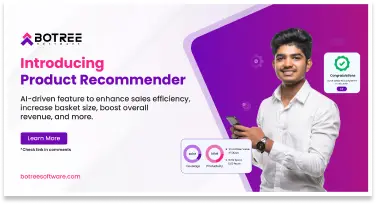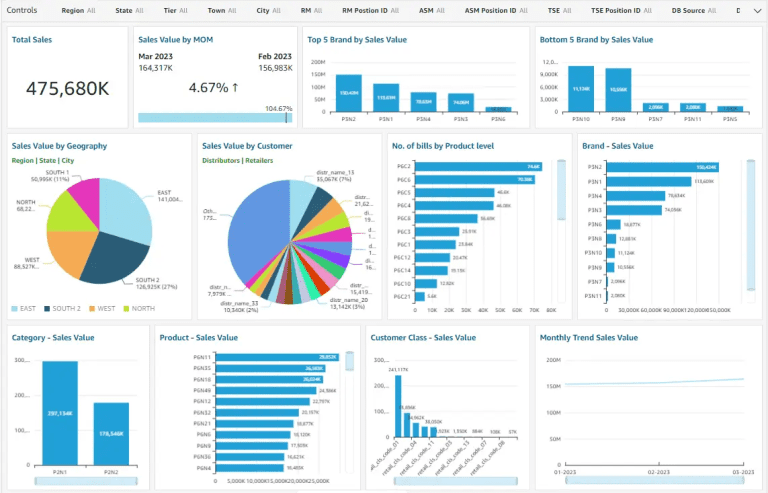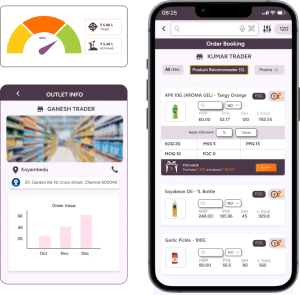
Achieving Visual Merchandising Excellence with Botree Software
Achieving Visual Merchandising Excellence with Botree Software Share: Share on

Achieving Visual Merchandising Excellence with Botree Software Share: Share on

Introducing the AI-Driven Product Recommender to Maximize Basket Size at Every Outlet
We are thrilled to introduce our latest innovation, the Product Recommender, designed to transform the way businesses optimize their product offerings and enhance sales productivity.

Running an FMCG company is a lot like operating a well-oiled machine — multiple moving parts must work in sync to keep products flowing, shelves stocked, and sales growing. At the heart of it all are the field salesmen who connect brands with retailers.
They also play an important role in maintaining retailer relationships, identifying sales opportunities, ensuring stock availability, and gathering market intelligence to fine-tune strategies. However, without a structured approach, inefficiencies can creep in, leading to missed opportunities and lost sales.
Here’s where the beat plan comes in. It provides a dynamic, day-to-day structure that optimizes your sales team’s store visits. When paired with the long-term vision of a Permanent Journey Plan (PJP), it forms the foundation of a productive field sales strategy.
In this article, we’ll explore how you can build a revenue-driven beat plan over your permanent journey plan, along with how automation software like Botree SFA can make the process a lot easier.
A beat plan is a day-level route that helps field representatives outline the sequence of outlets to visit, guaranteeing full outlet coverage and eliminating the risk of retailers being overlooked. It involves two components: who to visit on a particular day and what route to follow.
When creating a beat plan, you can plan the frequency of store visits by considering:
Here’s where sales force automation solutions like Botree SFA can help. They help you approach beat planning with a data-driven approach, helping you identify high-performing outlets, analyze stock demand trends, and automate store visit sequences based on location, frequency, and other relevant factors.

FMCG success depends on consistent product availability and timely restocks. This means sales teams need a system to know when to visit stores and replenish stock, a.k.a. a beat plan. Some challenges that FMCG companies without a beat plan face are:
However, by planning your beats, you can ensure shelves are consistently stocked, minimizing stockouts and maximizing profits. But beat planning — creating a daily visit schedule for field agents — is just one half of the picture. For the best results, you need to sync your beat plan with your permanent journey plan.
A Permanent Journey Plan (PJP) is a long-term schedule used by sales teams in the FMCG and retail sectors to visit outlets at predetermined intervals. Unlike the dynamic beat plans, PJPs are designed for consistency over months or even years — ensuring reliable and predictable coverage of retail outlets.
Moreover, PJPs help you prioritize high-value retailers, ensuring your top accounts receive consistent, scheduled attention. With the PJP’s long-term outlook, you can spot sales trends, understand which products sell fast, and predict demand with more accuracy. That means fewer stockouts, less overproduction, and a supply chain that keeps up with customer demands.
Put simply, PJP sets the foundation, and beat plans keep it flexible to address daily fluctuations — whether that’s a field agent on leave or unexpected stock shortages.
Leverage software like Botree SFA to optimize your permanent journey and daily beat plans. We suggest two things:

Let’s quickly go over how a well-structured beat plan integrated with a Permanent Journey Plan (PJP) can help FMCG brands:
Basically, when your beat plan and PJP sync up, your sales team works more efficiently, achieves targets, and creates a smooth, reliable experience that drives both retailer satisfaction and steady revenue growth.
Nabati — a 40-year-old indulgent-snacking brand — entered India in 2015. Their goals were to establish category leadership, tap into a significant market opportunity, and expand their direct distribution network across India. Today, they’re the most widely distributed and No.1 wafer brand in India.
However, they soon realized their current SFA solution was not scaling well. It lacked the agility and advanced technology needed to effectively track efficiencies and support strategic decision-making for its growing operations in the Indian market.
So in 2023, they switched to Botree SFA and Botree DMS to manage their on-ground sales operations and distributor network. Today, 600+ salesmen from Nabati use Botree’s app to streamline their work and get nuanced insights on their performance.
And the result? With Botree SFA and DMS, Nabati was able to double its business growth, seeing a significant impact in sales productivity and outlet coverage. They saw:
And the best part: they also improved range selling with 100% route-to-market (RTM) adherence.

Use GPS-based mapping tools or AI-driven route optimization to fine-tune your beat plan and ensure smooth coverage.
Now that you have a basic idea of your outlet categories, the next step is to drill down. Collect historical data on each store, like:
Based on the data, decide how often each store should be visited.
Balancing high-revenue stores with high-demand stores: While high-demand stores are often the ones generating the most revenue (high-revenue), that’s not always the case. Some stores may sell lower volumes but experience frequent stockouts due to fast-moving items. So you need to track both sales data and stockout patterns to figure out your visit frequency.
You can integrate your SFA with DMS systems to track your orders vs order fulfillment rate. This can give you accurate data on retailer purchase patterns and market demand.
Read more on the importance of SFA & DMS Integrations
Territory allocation is one of the most important aspects of a beat plan. When done right, it ensures maximum market coverage, optimized travel time, and balanced workloads. But poor territory assignment can lead to inefficiencies, missed sales opportunities, and frustrated salesmen. We suggest focusing on three key factors:
The closer a salesman’s assigned stores are to their starting point, the more time they can spend visiting stores instead of commuting. Make sure to factor in real-world travel conditions, not just the distance on a map — some locations may be geographically close but harder to reach due to traffic or road conditions.
When developing beat plans, you need to ensure a fair distribution of workload across the sales team. It’s not as simple as assigning an equal number of outlets to each salesman. You need to consider the practicalities on the ground.
Your planning needs to account for both the travel time between stores and the anticipated time spent at each location. For example, a visit to a large hypermarket will require more time for relationship management and order taking when compared to a quick stock check at a smaller, local store.
Clearly defining territory boundaries prevents two salesmen from visiting the same area unnecessarily, leading to duplicate efforts and potential conflicts. We suggest mapping out all the stores in a region and assigning them to specific salesmen.
You can also use salesforce automation tools like Botree SFA to track your team’s locations and prevent overlaps.
First, map out your route in such a way that loops back to a salesman’s base location — this minimizes travel time and fuel costs. Then, plan for real-world challenges like traffic and road closures so your schedule is manageable even if there’s an unexpected delay.
We recommend adding a buffer time to your schedules to account for such disruptions. This gives your field force a bit of breathing room and helps prevent them from constantly feeling like they’re falling behind on their daily targets.
Make sure to factor in seasonal demand. If certain products sell more during specific seasons (e.g., cold beverages in summer), adjust beat plans accordingly to ensure stock availability at peak times.
The final step is to track and assess the effectiveness of your beat plan and PJP with some key performance indicators (KPIs). Some KPIs to track are:
You can also use simple surveys to get feedback on retailer engagement, analyze feature adoption and user experience. This helps you identify opportunities for improvement and pinpoint issues like missed visits, inefficient routes, or uneven territory coverage.
Traditional beat planning methods rely on fixed schedules, making it hard to adapt to real-time challenges like traffic or urgent store visits. This often leads to salesmen spending more time on the road and less time engaging with retailers and driving sales.
Botree SFA — with its AI and automation capabilities — can add that ‘dynamic flexibility’ to your beat planning, reducing unnecessary detours and fewer missed opportunities.
Here’s how —
In FMCG sales, a great beat plan and PJP keep your team moving efficiently — visiting priority stores, keeping products stocked, and maximizing sales. However, manual planning slows things down, leading to wasted time, missed visits, and lost revenue. Here’s where Botree SFA comes in.
It intelligently schedules store visits and optimizes routes based on location, priority, and real-time factors, guaranteeing efficient coverage of key outlets. Plus, your field teams get instant access to data like stock levels, order status, and specific retailer needs to make informed decisions on the ground.
The result? Your salesmen don’t just cover their territory on time but also make the most of each store visit.
Curious to learn more? Talk to our team to see how you can use Botree SFA to optimize your beat planning strategy and execution.
Meet Priyanka Allu, our in-house content marketing specialist. With a background in literature and communications, Priyanka brings in her expertise in crafting compelling brand narratives and engaging content across various marketing channels. Outside of work, you can find her quickly escaping from the mundane city life by the beach or mountains, spending quality time with loved ones.
